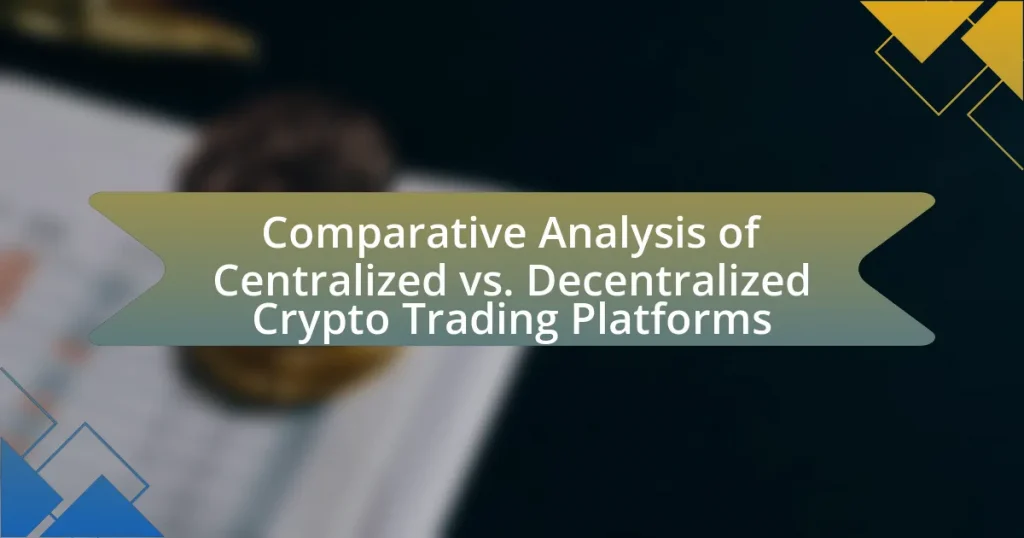The article provides a comparative analysis of centralized and decentralized crypto trading platforms, highlighting their operational mechanisms, key features, security measures, and user experiences. Centralized platforms, such as Binance and Coinbase, are characterized by their user-friendly interfaces, high liquidity, and reliance on a single organization for transaction management, while decentralized platforms like Uniswap and SushiSwap enable peer-to-peer trading without a central authority, offering enhanced privacy and control over assets. The article also discusses the advantages and disadvantages of each platform type, including regulatory implications, liquidity challenges, and user control over funds, ultimately guiding users in making informed decisions based on their trading needs and preferences.

What are Centralized and Decentralized Crypto Trading Platforms?
Centralized crypto trading platforms are exchanges operated by a single organization that facilitates trading by matching buyers and sellers, while decentralized crypto trading platforms operate without a central authority, allowing users to trade directly with one another through smart contracts. Centralized platforms, such as Binance and Coinbase, typically offer higher liquidity and user-friendly interfaces, but require users to trust the platform with their funds. In contrast, decentralized platforms like Uniswap and SushiSwap provide greater privacy and control over assets, but may face challenges with liquidity and user experience. The distinction is significant as centralized platforms accounted for approximately 90% of crypto trading volume in 2021, highlighting their dominance in the market.
How do Centralized Crypto Trading Platforms operate?
Centralized crypto trading platforms operate by acting as intermediaries that facilitate the buying and selling of cryptocurrencies among users. These platforms manage user accounts, hold funds, and execute trades on behalf of users, providing a streamlined experience. For instance, platforms like Binance and Coinbase allow users to deposit fiat or cryptocurrencies, which are then matched with other users’ orders through an order book system. This centralized control enables faster transaction processing and enhanced liquidity, as the platform can aggregate orders from multiple users. Additionally, centralized platforms often implement security measures, such as two-factor authentication and cold storage, to protect user assets. According to a report by Chainalysis, centralized exchanges accounted for over 90% of all cryptocurrency trading volume in 2021, highlighting their dominance in the market.
What are the key features of Centralized Crypto Trading Platforms?
Centralized crypto trading platforms are characterized by features such as user-friendly interfaces, high liquidity, and robust security measures. These platforms typically offer a seamless trading experience, allowing users to easily buy, sell, and trade various cryptocurrencies. High liquidity is often ensured through a large number of active users and trading pairs, which facilitates quick transactions at stable prices. Additionally, centralized platforms implement advanced security protocols, including two-factor authentication and cold storage for funds, to protect user assets. These features collectively enhance the overall trading experience and instill confidence among users in the safety and efficiency of their transactions.
What security measures are in place for Centralized Crypto Trading Platforms?
Centralized crypto trading platforms implement several security measures to protect user assets and data. These measures include two-factor authentication (2FA), which requires users to provide a second form of verification in addition to their password, significantly reducing unauthorized access. Additionally, many platforms utilize cold storage for the majority of their digital assets, keeping them offline and less vulnerable to hacking attempts.
Encryption protocols are also employed to secure user data during transactions, ensuring that sensitive information remains confidential. Regular security audits and penetration testing are conducted to identify and rectify vulnerabilities within the platform. Furthermore, compliance with regulatory standards, such as Anti-Money Laundering (AML) and Know Your Customer (KYC) policies, adds an extra layer of security by verifying user identities and monitoring transactions for suspicious activity.
These measures collectively enhance the security posture of centralized crypto trading platforms, making them more resilient against cyber threats.
How do Decentralized Crypto Trading Platforms operate?
Decentralized crypto trading platforms operate by enabling peer-to-peer transactions without the need for a central authority or intermediary. These platforms utilize blockchain technology to facilitate trades directly between users, ensuring that transactions are recorded on a distributed ledger, which enhances transparency and security. Smart contracts, which are self-executing contracts with the terms of the agreement directly written into code, automate trade execution and settlement, reducing the risk of fraud and increasing efficiency. According to a report by Chainalysis, decentralized exchanges accounted for over 30% of all crypto trading volume in 2021, highlighting their growing significance in the market.
What are the key features of Decentralized Crypto Trading Platforms?
Decentralized crypto trading platforms are characterized by key features such as peer-to-peer trading, enhanced privacy, and control over funds. These platforms facilitate direct transactions between users without intermediaries, allowing for greater autonomy and reduced reliance on centralized authorities. Enhanced privacy is achieved through the use of blockchain technology, which enables users to trade without disclosing personal information. Additionally, users maintain control over their funds, as they do not need to deposit assets into a centralized exchange, minimizing the risk of hacks or mismanagement. According to a report by CoinMarketCap, decentralized exchanges have seen significant growth, with trading volumes increasing as users seek alternatives to centralized platforms.
What security measures are in place for Decentralized Crypto Trading Platforms?
Decentralized crypto trading platforms implement several security measures to protect users and their assets. These platforms utilize smart contracts to automate transactions, reducing the risk of human error and fraud. Additionally, they often employ cryptographic techniques to secure user data and transactions, ensuring that sensitive information remains confidential.
Furthermore, decentralized platforms typically do not hold users’ funds, which minimizes the risk of hacking incidents that can occur in centralized exchanges. Instead, users maintain control of their private keys, enhancing security. Many decentralized platforms also incorporate multi-signature wallets, requiring multiple approvals for transactions, which adds an extra layer of protection against unauthorized access.
These security measures are essential in maintaining user trust and ensuring the integrity of transactions within the decentralized finance ecosystem.
What are the main differences between Centralized and Decentralized Crypto Trading Platforms?
Centralized crypto trading platforms are operated by a single organization that manages all transactions and user data, while decentralized crypto trading platforms operate on a blockchain network without a central authority, allowing users to trade directly with one another. Centralized platforms typically offer higher liquidity and faster transaction speeds due to their control over the order book, whereas decentralized platforms provide greater privacy and security, as users retain control of their private keys and funds. Additionally, centralized platforms often require users to complete identity verification processes, while decentralized platforms usually allow for anonymous trading.
How do user experiences differ between Centralized and Decentralized platforms?
User experiences differ significantly between centralized and decentralized platforms primarily in terms of control, security, and accessibility. Centralized platforms, such as traditional exchanges, offer a user-friendly interface and customer support, but users relinquish control over their assets to the platform, which can lead to vulnerabilities like hacks or service outages. In contrast, decentralized platforms empower users with full control over their assets, enhancing security through blockchain technology, but often present a steeper learning curve and less immediate support. For instance, a study by Chainalysis in 2021 indicated that centralized exchanges accounted for 75% of crypto trading volume, highlighting their popularity despite the risks associated with asset control.
What are the regulatory implications for Centralized vs. Decentralized platforms?
Centralized platforms face stricter regulatory scrutiny compared to decentralized platforms due to their control over user funds and data. Regulatory bodies often require centralized exchanges to comply with anti-money laundering (AML) and know your customer (KYC) regulations, as they can easily identify and monitor transactions. In contrast, decentralized platforms typically operate without a central authority, making it challenging for regulators to enforce compliance, which can lead to a more lenient regulatory environment. However, this lack of oversight can also raise concerns about security and fraud, prompting some jurisdictions to consider regulations that could impose certain standards on decentralized platforms.

What are the advantages and disadvantages of Centralized Crypto Trading Platforms?
Centralized crypto trading platforms offer several advantages and disadvantages. The primary advantage is their user-friendly interface and high liquidity, which facilitates quick transactions and access to a wide range of cryptocurrencies. For instance, platforms like Binance and Coinbase have millions of users, providing substantial liquidity that allows for efficient trading. Additionally, centralized platforms often provide robust security measures, such as two-factor authentication and insurance against hacks, enhancing user trust.
Conversely, the main disadvantage of centralized crypto trading platforms is the risk of hacks and regulatory scrutiny. Centralized exchanges hold users’ funds in a single location, making them attractive targets for cybercriminals. For example, the 2014 Mt. Gox hack resulted in the loss of approximately 850,000 Bitcoins, highlighting the vulnerabilities associated with centralized storage. Furthermore, these platforms may be subject to government regulations, which can lead to restrictions on trading activities or even the shutdown of services in certain jurisdictions.
What benefits do users gain from Centralized Crypto Trading Platforms?
Users gain several benefits from Centralized Crypto Trading Platforms, including enhanced security, user-friendly interfaces, and access to a wide range of trading pairs. Centralized platforms typically employ advanced security measures, such as two-factor authentication and cold storage, to protect user funds. Additionally, these platforms offer intuitive interfaces that simplify the trading process, making it accessible for both novice and experienced traders. Furthermore, centralized exchanges often provide liquidity and faster transaction speeds, enabling users to execute trades efficiently. According to a report by CoinMarketCap, centralized exchanges account for over 90% of the total trading volume in the cryptocurrency market, highlighting their popularity and reliability among users.
How does liquidity impact trading on Centralized platforms?
Liquidity significantly impacts trading on centralized platforms by determining the ease and speed at which assets can be bought or sold without causing substantial price changes. High liquidity on these platforms allows traders to execute large orders quickly, minimizing slippage and ensuring that market prices remain stable. For instance, centralized exchanges like Binance and Coinbase often experience high trading volumes, which enhances liquidity, enabling users to transact efficiently. Conversely, low liquidity can lead to increased volatility and wider bid-ask spreads, making it more challenging for traders to enter or exit positions at desired prices. This relationship between liquidity and trading efficiency is crucial, as evidenced by data showing that higher liquidity correlates with reduced price fluctuations and improved market depth on centralized exchanges.
What customer support options are available on Centralized platforms?
Centralized platforms typically offer multiple customer support options, including live chat, email support, and phone support. These options allow users to receive immediate assistance, submit inquiries, or resolve issues efficiently. For instance, many centralized exchanges like Coinbase and Binance provide 24/7 live chat support, ensuring users can access help at any time. Additionally, centralized platforms often maintain comprehensive help centers or FAQs, which serve as valuable resources for common questions and troubleshooting.
What challenges do users face with Centralized Crypto Trading Platforms?
Users face several challenges with centralized crypto trading platforms, primarily including security risks, lack of control over funds, and regulatory issues. Security risks arise from the potential for hacking incidents, as evidenced by high-profile breaches like the Mt. Gox collapse in 2014, where approximately 850,000 Bitcoins were stolen. Users also experience a lack of control over their funds since these platforms hold private keys, making users reliant on the platform’s security measures. Additionally, regulatory scrutiny can lead to sudden changes in service availability or compliance requirements, impacting user access and trading capabilities. These challenges highlight the vulnerabilities inherent in centralized systems compared to decentralized alternatives.
What risks are associated with Centralized platforms?
Centralized platforms pose several risks, including security vulnerabilities, lack of user control, and regulatory compliance issues. Security vulnerabilities arise because centralized platforms store user data and funds in a single location, making them attractive targets for hackers; for instance, the 2014 Mt. Gox hack resulted in the loss of 850,000 Bitcoins, highlighting the potential for significant financial loss. Lack of user control is evident as users must trust the platform to manage their assets, which can lead to issues such as withdrawal restrictions or platform insolvency. Additionally, centralized platforms often face regulatory scrutiny, which can result in sudden changes in service availability or legal actions that affect users, as seen with various exchanges being shut down or fined for non-compliance with local laws.
How do Centralized platforms handle user data privacy?
Centralized platforms handle user data privacy by implementing strict data protection policies and security measures. These platforms typically collect, store, and manage user data on their servers, which allows them to control access and ensure compliance with regulations such as the General Data Protection Regulation (GDPR). For instance, centralized exchanges often utilize encryption, access controls, and regular security audits to safeguard user information. Additionally, they may anonymize data to protect user identities while still utilizing the data for operational purposes. This approach is validated by the fact that centralized platforms are often required to adhere to legal frameworks that mandate user data protection, ensuring a level of accountability and transparency in their data handling practices.

What are the advantages and disadvantages of Decentralized Crypto Trading Platforms?
Decentralized crypto trading platforms offer several advantages and disadvantages. The primary advantage is enhanced security, as users retain control of their private keys, reducing the risk of hacks associated with centralized exchanges. Additionally, these platforms promote privacy and anonymity, allowing users to trade without disclosing personal information. They also provide greater accessibility, enabling users from regions with banking restrictions to participate in trading.
Conversely, the disadvantages include lower liquidity compared to centralized platforms, which can lead to higher price volatility. Furthermore, decentralized platforms often have a steeper learning curve for new users, as they require a better understanding of blockchain technology and wallet management. Transaction speeds can also be slower due to network congestion, and users may face challenges with customer support, as decentralized platforms typically lack centralized assistance.
What benefits do users gain from Decentralized Crypto Trading Platforms?
Users gain several benefits from Decentralized Crypto Trading Platforms, including enhanced security, greater privacy, and increased control over their assets. Enhanced security arises from the absence of a central authority, which reduces the risk of hacking and fraud, as funds are stored in users’ wallets rather than on a centralized exchange. Greater privacy is achieved since users can trade without providing personal information, aligning with the principles of anonymity in cryptocurrency. Increased control over assets allows users to manage their funds directly, eliminating reliance on third parties and reducing the risk of asset seizure. These benefits are supported by the growing adoption of decentralized finance (DeFi), which has seen a significant increase in total value locked, reaching over $80 billion in 2021, indicating user trust and preference for decentralized solutions.
How does user control over funds differ in Decentralized platforms?
User control over funds in decentralized platforms is significantly greater than in centralized platforms. In decentralized platforms, users retain full ownership of their private keys, which means they have direct control over their funds without relying on a third party. This contrasts with centralized platforms, where users deposit funds into the platform’s wallet, and the platform controls the private keys, limiting user autonomy and increasing the risk of loss due to hacks or platform failures. According to a report by Chainalysis, decentralized finance (DeFi) platforms have seen a surge in user adoption, highlighting the appeal of enhanced control and security.
What role does transparency play in Decentralized platforms?
Transparency is crucial in decentralized platforms as it fosters trust among users by allowing them to verify transactions and operations independently. This transparency is achieved through the use of blockchain technology, which records all transactions in a public ledger that is immutable and accessible to anyone. For instance, Bitcoin’s blockchain enables users to trace the history of transactions, ensuring accountability and reducing the risk of fraud. Furthermore, transparency in decentralized platforms often leads to enhanced security, as the open nature of the system allows for continuous scrutiny and improvement by the community, thereby mitigating vulnerabilities.
What challenges do users face with Decentralized Crypto Trading Platforms?
Users face several challenges with decentralized crypto trading platforms, primarily including issues related to liquidity, user experience, and security. Liquidity can be significantly lower on decentralized platforms compared to centralized ones, making it difficult for users to execute large trades without impacting market prices. User experience is often hindered by complex interfaces and the need for users to manage their own private keys, which can lead to mistakes and loss of funds. Additionally, while decentralized platforms aim to enhance security by eliminating central points of failure, they can still be vulnerable to smart contract bugs and phishing attacks, which pose risks to users’ assets. These challenges highlight the trade-offs users must consider when choosing between decentralized and centralized trading options.
What are the common technical issues encountered on Decentralized platforms?
Common technical issues encountered on decentralized platforms include scalability challenges, security vulnerabilities, and interoperability problems. Scalability issues arise as user demand increases, often leading to slower transaction times and higher fees, as seen during peak usage periods on networks like Ethereum. Security vulnerabilities can manifest through smart contract bugs or exploits, which have resulted in significant financial losses, such as the DAO hack in 2016 that led to a loss of $60 million. Interoperability problems occur when different decentralized platforms cannot communicate effectively, limiting user experience and functionality, as evidenced by the fragmentation of assets across various blockchain networks.
How does the lack of customer support affect users on Decentralized platforms?
The lack of customer support on decentralized platforms significantly impacts users by leaving them without assistance during critical issues. Users often face challenges such as transaction errors, security concerns, or technical difficulties, and without a support system, they may struggle to resolve these problems effectively. Research indicates that 70% of users abandon a platform due to inadequate support, highlighting the importance of responsive customer service in maintaining user engagement and trust. Consequently, the absence of customer support can lead to frustration, loss of funds, and diminished user confidence in decentralized platforms.
How can users choose between Centralized and Decentralized Crypto Trading Platforms?
Users can choose between centralized and decentralized crypto trading platforms by evaluating factors such as security, control, fees, and user experience. Centralized platforms, like Coinbase, offer higher liquidity and user-friendly interfaces but require users to trust a third party with their funds. In contrast, decentralized platforms, such as Uniswap, provide greater control over assets and enhanced privacy but may have lower liquidity and a steeper learning curve. According to a report by Chainalysis, decentralized exchanges accounted for 12% of total crypto trading volume in 2020, indicating a growing preference for user autonomy. Thus, users should assess their priorities regarding trust, control, and ease of use when making their choice.
What best practices should users follow when using Crypto Trading Platforms?
Users should follow several best practices when using crypto trading platforms to ensure security and maximize their trading efficiency. First, users must enable two-factor authentication (2FA) on their accounts, which significantly reduces the risk of unauthorized access. According to a report by the Cybersecurity & Infrastructure Security Agency, enabling 2FA can prevent 99.9% of automated attacks.
Second, users should conduct thorough research on the platform’s reputation and security features before trading. A study by Chainalysis found that platforms with strong security measures and positive user reviews are less likely to experience hacks or fraud.
Third, users must keep their private keys secure and avoid sharing them, as losing control of private keys can lead to irreversible loss of funds. The Bitcoin whitepaper emphasizes the importance of private key security in maintaining ownership of digital assets.
Lastly, users should diversify their investments and not put all their funds into a single asset or platform, as this strategy mitigates risk. Historical data shows that diversification can lead to more stable returns over time, as evidenced by various investment studies.















